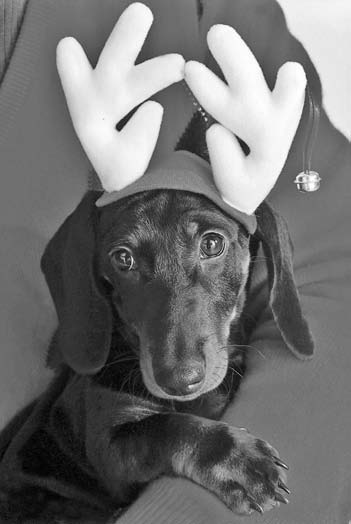- Using your personal profile to understand your training challenges
- Getting the scoop on the benefits of obedience classes
Every person has a unique nature and personality; attempting to practice any daily behavior that goes against your personality is probably futile. If you’re crazy about chocolate, a diet of tofu and bean sprouts probably won’t last for more than a day or two (just ask me — I know). You have to find a lifestyle that makes sense for your personal tastes and level of willpower.
Forming Your Personal Training Style
Remember
Different people have different training styles. Play-based training or short drills, food rewards or praises and pats, learning tricks or unlearning bad habits — all are effective and possible as long as the training is consistent, loving, practiced daily, based on positive reinforcement rather than punishment, and fun for both you and your Dachshund. The following sections allow you to determine your training profile and form a training plan that will be effective and long-lasting.
Determining your training profile
A. Throw in some treats, push her inside gently but firmly, and shut the door. She’ll get used to it.
B. Throw in some treats, offer some encouraging words, and then ignore her. If you aren’t interesting to play with, the treats will seem more attractive and she’ll go inside eventually.
C. Think to yourself, “The crate looks so cold and uninviting. I can’t possibly leave her in there all alone . . . that would be so mean.”
A. In her crate. She won’t even get a chance to learn how to beg in your house!
B. Lying quietly nearby, on the kitchen floor. You’re determined not to reinforce her begging by giving her table food, but you hate to have her miss out on the family dinnertime, because she is part of the family.
C. Under the table with her front paws on your lap, or staring winsomely at you and watching your fork with an eagle eye. She knows where to get the goods. Hey, is it really fair that you get to eat this good food and she has to be denied?
A. During training when she fulfills a request.
B. To reinforce any good behavior.
C. Probably too often, but when she looks at the dog cookie jar with such longing, you can’t resist. You want to make her happy.
A. A breeze. You crate-trained your Dachshund, and she learned the ropes in a week. She never had an accident inside.
B. Fairly successful. You’re still working on it, but she’s getting the picture because you take her outside at the same times every single day. She still makes the occasional mistake, but you clean it up right away.
C. Um . . . To be honest, you just aren’t comfortable with the crate because she whines so pitifully in there, and you can’t seem to remember to take her out on a schedule. But that’s okay, because you don’t mind cleaning up the messes all that much.
A. Strictly regimented. You hold them at the same time each day, and you have a planned schedule of what you’ll cover in each session.
B. Daily, but they’re pretty informal and fun.
C. Wait a minute . . . training? Isn’t that sort of authoritarian? But come to think of it, you do ask your Dachshund to sit or stay or do whatever seems fun at the moment.
A. To train her for competition — either in obedience, agility, field trials, or wherever her talents are (see Chapter Advanced Training and Competing for Fun).
B. To have a well-behaved family pet that knows and follows the house rules most of the time.
C. To have a buddy and best friend. You aren’t too concerned about whether she can do tricks. You just want her around for cuddling.
A. Immediately restrict her food intake and increase the length of her walks.
B. Cut back on the treats and begin measuring her kibble so that you don’t overestimate. You also become more careful about walking her every day rather than skipping the walks when you don’t feel like it.
C. Buy lower-calorie treats and try to cut back on her food. But, when she acts like she’s starving, you often give in and give her just a little bit more. After all, most people carry a few extra pounds, too. What harm could it do?
A. You completely ignore her when she barks or put her in her den when she gets too loud — especially if she’s outside disturbing the neighbors. No one should have to listen to such excessive noise.
B. Recognize that Dachshunds bark but that excessive barking isn’t tolerable. You keep the blinds shut on the front windows and ignore her when she barks at you. You make her come inside if she barks in the yard. Otherwise, you pay attention because she may be alerting you to something.
C. You think to yourself, “Dachshunds bark. What about it?” You don’t mind so much. Besides, if your friends don’t like it, maybe they really aren’t your friends at all!
A. Peace and quiet, with your Dachshund curled up in her den, sleeping through the night (after the first few weeks).
B. An occasional trip outside, but mostly your Dachshund sleeps nicely under the covers with you.
C. Broken sleep. Every time your Dachshund makes a noise, you wake up and take her out or give her a toy to chew. You’ve even found yourself playing with her at 3 a.m. because she wants to play. You aren’t getting much sleep, but you feel like your Dachshund needs the attention. You only hope she’ll grow out of this stage and sleep through the night so you can, too.
A. Your Dachshund stays in her den or in an enclosed, pet-proofed area (see Chapter Making Your Home Dachshund-Proof). You either come home for lunch to let her out or hire a pet sitter or dog walker to cover the lunch hour.
B. Your Dachshund stays in the kitchen with a baby gate that keeps her out of the carpeted areas. Sometimes she chews things, but you’re working on that bad habit. You come home for lunch as often as you can. When you don’t, you usually have a mess to clean up.
C. Your Dachshund gets free reign of the house. You feel so guilty for leaving her that you think she deserves to shred the trash and have a few accidents. You can’t blame her.
Warning!
Letting your Dachshund puppy run free in the house when you’re away from home can result in more than just property damage. Your Dachshund can be seriously injured or poisoned if she ingests certain types of trash or other foreign objects or substances. Dachshundproof any room in which your pup will be left unsupervised for any length of time. Better yet, let her snooze in her den when you’re away.
Developing a personalized training plan
If you answer mostly As
Tip
Consider training your Dachshund for professional competition, if your dog has what it takes (see Chapters Defining the Dashing Dachshund and Advanced Training and Competing for Fun). You certainly do.
Remember
Your one challenge? Remembering to be fun. Consistency and schedules can get tedious if you don’t maintain your sense of humor when others aren’t quite as disciplined as you are. When your Dachshund slips up, gently nudge her back on track. Don’t get angry or irritable when she doesn’t measure up to your high standards. Instead, keep working with her (see Chapter Putting Your Dachshund through Basic Training for troubleshooting tips). She’ll get it, and if she can trust you to be kind and loving in your firmness, she’ll do anything for you.
If you answer mostly Bs
Remember
Your biggest challenge? Keeping a schedule and remembering to train every day. Dogs thrive on consistency and regularity even more than humans do, so a routine is important for your dog — even if you can’t always follow it. You’ll do a great job, however; your Dachshund is lucky to have a pet owner as caring and responsible as you are!
If you answer mostly Cs
- Three meals (measure that kibble, please, or you’ll overestimate)
- One grooming session
- One or two walks
- Two or three short training sessions
Remember
Many dogs are surrendered to animal shelters because their owners never bothered to fully housetrain them, and then they got tired of cleaning up after them. The next time you think crate-training or any other housetraining method is cruel, remember that surrendering your Dachshund to an animal shelter is much crueler. Do the kind thing and housetrain your Dachshund with consistency and vigilance (see Chapter Teaching Your Dachshund the House Rules). And remember: Dogs love their dens (or, they learn to love them)!
Attending Obedience Classes (For Your Dachshund and You)
Have some class: Avoid dumping at the shelterAccording to a study published in 2000 in the Journal of Applied Animal Welfare Science, the pet owners who relinquished dogs to 12 U.S. animal shelters broke down into the following categories:
|
Remember
No matter how good you think you are at training your Dachshund at home, obedience classes are a great experience for both you and your Dachshund. Every dog should experience them — as long as their owners can find good trainers. A seasoned dog trainer should give you ideas and strategies that hadn’t occurred to you. He or she can help you deal with individual problems or tendencies of your own pet — something no book can do. Also, learning good behavior in a place other than your living room, and in the presence of other dogs, will help your Dachshund see that training applies everywhere, not just at home.
– Ask your vet to recommend a good local trainer.
– Ask your dog’s breeder, who may know just the right person.
– Ask friends with well-behaved dogs where they learned how to train their pets.
– Contact the Association of Pet Dog Trainers — an organization devoted to better dog training through education, and a great advocator of positive training methods. You can search for an APDT-certified trainer in your area at www.apdt.com (click on Dog Trainer Search) or you can give the organization a call at 1-800-PET-DOGS. Call Monday through Friday from 8:30 a.m. to 5:00 p.m. Eastern Standard Time.
Technical Stuff
Lure-and-reward training is a method in which a lure, such as a treat or piece of kibble, is used to physically guide your dog into a position, such as a sit. Clicker training is a method in which a click from a plastic device (called a clicker) is associated with a food treat. Eventually, the click itself becomes rewarding to the dog and is used as a positive reinforcement for desired behavior. Play training is a method in which practice of certain commands is disguised as play.
Remember
Don’t forget your intuition. If a trainer just seems wrong, for whatever reason, keep looking. If you feel good about a trainer and his or her methods make sense to you — they seem humane, kind, and in the best interest of the dogs — feel free to sign up.
Good luck and don’t delay. Start training your Dachshund today!
by Eve Adamson







